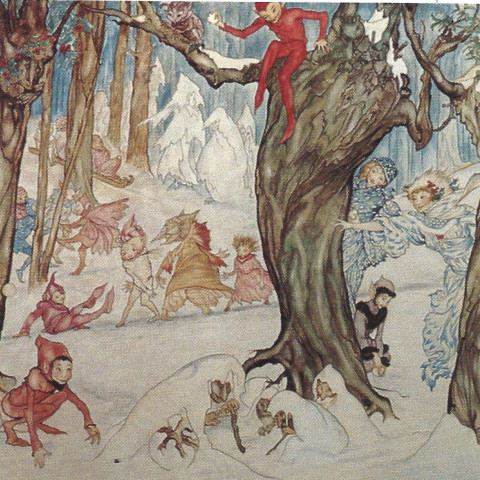The pre-eminent illustrator of the Edwardian Age, whose imaginative work graces such children's classics as Alice in Wonderland, Grimm's Fairytales, and many others, he was born on September 19, 1867, in London, England, as one of twelve children. A student at the City of London School, Arthur became known for his artistic gift, winning many prizes for his artwork. While he began working as a clerk at the Westminster Fire Office at age 18, he continued his art studies at the Lambeth School of Art in his spare time, and submitted some illustrations to publications like Scraps and Chums.
In 1892, Rackham left his safe position as a clerk to explore a career in illustration, and worked as a reporter at the Westminster Budget to earn a living. First book illustrations followed (1893), but it wasn't until 1896, the publication of the book The Zankiwank and the Bletherwitch, that his work began showing hints of the whimsical, magical style, later to become his hallmark. Rackham illustrated close to twenty books in the 1890s, also creating images for major children's magazines. There were adventure and fantasy books, fairytales and legends, as well as books on English gardens, and fishing and hunting.
In 1905, when a new edition of the Washington Irving classic Rip van Winkle was published, it contained 51 color plates by Rackham, his first major book, by far, and the manifestation of his style. He went on to create much acclaimed illustrations for books like Peter Pan in Kensington Garden (1906), Alice's Adventures in Wonderland (1907), A Midsummer-Night's Dream (1908), Undine (1910), The Rhinegold and the Valkyrie, and Siegfried and The Twilight of the Gods (1910, 1911).
A master in the use of watercolor, Rackham was a skilled draftsman and a gifted and imaginative observer of human nature. "He was-and remains-a soloist in front of an orchestra, a player with the responsibility to interpret and add a personal lustre to great works with variations of infinite sublety and grace." (Arthur Rackham: A Life with Illustration, by James Hamilton, Pavilion Books, London, 1990).
He was an elected member of the Royal Watercolor Society, the Société Nationale des Beaux Arts, and Master of the Art Worker's Guild. In 1906, he won a gold medal for his work in Milan, Italy, and in Barcelona, Spain, in 1911. His illustrations are known and collected around the world.
Arthur Rackham died in England in 1939.
Sources include:
James Hamilton, Arthur Rackham: A Life with Illustration, London, 1990
www.angelfire.com/ar/Arthur Rackham Society/ars03.html
www.bpip.com/illustrat/rackham.htm

